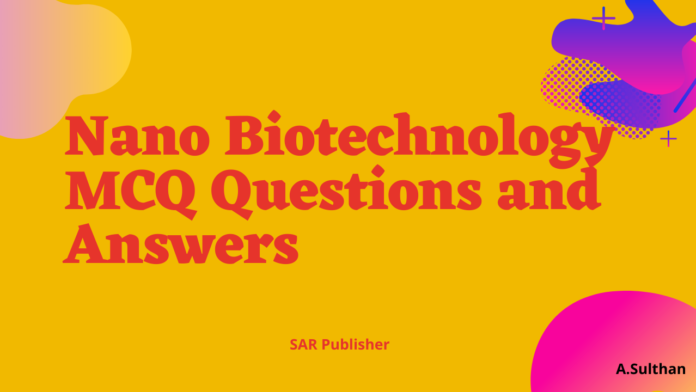Nano Biotechnology MCQ Questions and Answers Part – 1
Nano Biotechnology MCQ Questions and Answers Part – 2
Nano Biotechnology MCQ Questions and Answers Part – 3
101. Molecular computing machines use _____ chips.
A. enzymes.
B. silicon.
C. DNA.
D. a and b.
ANSWER: D
102. Expand BECON.
A. Biomedical Engineering Consortium.
B. Biomedical Financing Administration.
C. National Institute of Health.
D. Biomedical Engineering Administration.
ANSWER: A
103. The 1996 Nobel Prize in chemistry to Harold W.Kro to, Robert F. Curl and Richard.E. Smalley was for their discovery of _______ in 1985.
A. bucky balls.
B. fullerenes.
C. nanotubes.
D. nanowires.
ANSWER: A
104. A closed cage structure of icosahedral symmetry with 20 hexagonal and 12 pentagonal rings are called as _________.
A. crystals.
B. fullerenes.
C. carbon balls.
D. nanoparticles.
ANSWER: B
105. What type of nanomaterials has antioxidant properties?
A. Nanowires.
B. Nanotubes.
C. Fullerenes.
D. Buckyballs.
ANSWER: C
106. Which of the following are applications of polymer-silicate nanocomposites?
A. Drug and gene delivery.
B. Cell sheet.
C. Bioassay.
D. All the above.
ANSWER: D
107. Which of the following polymers are used in bioglass nanocomposites.
A. PCL and PLA.
B. P3HB and Gelatin.
C. Both a and b.
D. a alone.
ANSWER: C
108. Which of the following is an organically modified silicate nanoparticles?
A. PLA.
B. Collagen.
C. PCL.
D. Cloisite clay.
ANSWER: D
109. Expand HPLC.
A. High-Performance Liquid Chromatography.
B. High Protein Liquid Chromatography.
C. High-Pressure Liquid Chromatography.
D. High-Performance Liquid Cytometry.
ANSWER: A
110. The bases in DNA are ________.
A. G-T, A-C.
B. A-T, G-C.
C. A-G, C-T.
D. A-U, C-T.
ANSWER: B
111. Which metal is used with nanoparticles for antibiotic delivery?
A. Gold.
B. Titanium.
C. Zinc.
D. Silver.
ANSWER: D
112. The field that permits the modeling and simulation of complex nanometer scale structures is called ______.
A. wet nanotechnology.
B. computational biology.
C. computational biotechnology.
D. dry nanotechnology.
ANSWER: C
113. The RNA that has enzymatic activities are _________.
A. enzyme.
B. riboswitch.
C. ribozyme.
D. ribosome.
ANSWER: C
114. C6HyFn is ________.
A. fullerene.
B. hydrated fullerene.
C. nanoparticle.
D. carbon particle.
ANSWER: B
115. Which of the following is NOT an application of fullerenes?
A. Organic photovoltaics.
B. Antioxidants.
C. Additives.
D. Imaging.
ANSWER: D
116. Expand CNT.
A. Copper Nano Tube.
B. Carbon Nano Tube.
C. Cell Nano Tube.
D. Crystal Nanotube.
ANSWER: B
117. Expand HCFA.
A. Health Care Financing Administration.
B. Human Care Food Administration.
C. Health Care Food Administration.
D. Health Care Financing Administration.
ANSWER: A
118. Expand PAFC.
A. Photo Flow Cytometry.
B. Photothermal Flow Cytometry.
C. Photo Advanced Flow Cytometry.
D. Photo Acoustic Flow Cytometry.
ANSWER: D
119. Expand TDM.
A. Transmission Electron Microscopy.
B. Transmission Digital Microscopy.
C. Transmission Diffusion Microscopy.
D. Transmission Detective Microscopy.
ANSWER: B
120. Nanoemulsions are otherwise called as _______.
A. submicron emulsion.
B. mini emulsion.
C. oil in water emulsion.
D. both a and b.
ANSWER: C
121. ______ is a suspension of particles in the range from 1nm to 1 micrometre in size.
A. Emulsion.
B. Suspension.
C. Colloid.
D. Hydrosol.
ANSWER: C
122. _____ is a filtration process using membranes with pore size ranging from 1 to 10nm.
A. Nanofilms.
B. Nanomembranes.
C. Nano sieves.
D. Nanofiltration.
ANSWER: D
123. Expand XRD.
A. X-ray.
B. X-ray diffraction.
C. X-ray diode.
D. X-ray dot.
ANSWER: B
124. Substances that affect neurotransmitter on components of the nervous system are called as ___________.
A. acetylcholine.
B. phosphatidylcholine.
C. vitamin B12.
D. cholinergic.
ANSWER: D
125. The quantum dot of the same material of different sizes can emit light of different colours. This effect is called as ________.
A. quantum dot effect.
B. quantum confinement effect.
C. quantum enhancement effect.
D. bandgap.
ANSWER: B
126. Fluorophore nanocrystals are otherwise called as ________.
A. fluors.
B. quantum dots.
C. nano fluors.
D. micro fluors.
ANSWER: C
127. siRNAs delivery uses which of the following nanotechnology?
A. Nanoshells.
B. Nanocapsules.
C. Fullerenes.
D. Quantum dots.
ANSWER: D
128. What are the approaches used in nanofabrication?
A. Top-up.
B. Bottom down.
C. Both a and b.
D. Neither a nor b.
ANSWER: C
129. Fullerenes are soluble in ________.
A. water.
B. aromatics.
C. carbon disulfide.
D. both b and c.
ANSWER: D
130. Which of the following is NOT a type of fullerene?
A. Nano onions.
B. Nanotubes.
C. Buckyballs.
D. Quantum dots.
ANSWER: D
131. The solid-state manifestation of fullerenes and related compounds are called ________.
A. mega tubes.
B. fullerene rings.
C. fullerites.
D. nanotubes.
ANSWER: C
132. Atoms trapped inside fullerenes to form inclusion compounds is known as __________.
A. ultrahard fullerite.
B. fullerene.
C. inclusion body.
D. endohedral fullerenes.
ANSWER: D
133. MEMS originated in _____ year.
A. 1951.
B. 1950.
C. 1952.
D. 1960.
ANSWER: B
134. _____ is the process of making inferences and predictions about biological networks.
A. Biological network.
B. Biology of network.
C. Network in biology.
D. Neural network.
ANSWER: A
135. ___________ network approach their complete structure even in the simplest bacteria.
A. Neural.
B. Neuron.
C. Biological.
D. Chemical.
ANSWER: C
136. Primary input into the _____ would be data from a set of experiments measuring protein activation/inactivation across a set of proteins.
A. inference algorithms.
B. interference algorithms.
C. network algorithms.
D. biological algorithms.
ANSWER: A
137. In a metabolic network, primary input into an algorithm would be data from a set of experiments measuring _______ level.
A. energy.
B. metabolism.
C. metabolite.
D. atomic.
ANSWER: C
138. _____ is an electrically excitable cell that processes and transmits information by electrical and chemical signalling.
A. Biological neuron.
B. Neuron biology.
C. Neuron.
D. Nerve cells.
ANSWER: A
139. A neuron is an electrically excitable cell that processes and transmits information by ______ and ______ signalling.
A. electrical, biological.
B. electrical, chemical.
C. mechanical, electrical.
D. chemical, mechanical.
ANSWER: A
140. Neurons communicate by chemical and electrical synapsis in a process known as ______ transmission
A. axon.
B. neuron.
C. biological.
D. synaptic.
ANSWER: D
141. In the case of modeling a biological neuron, physical analogues are used in the place of abstractions such as ______ and transfer function.
A. mass.
B. length.
C. height.
D. weight.
ANSWER: D
142. The term ________ network was traditionally used to refer to a network or circuit of biological neurons.
A. neural.
B. neuron.
C. nerve.
D. axon.
ANSWER: A
143. _______ neural network involves a network of simple processing elements, which can exhibit complex global behaviour determined by the
connections between the processing elements and element parameters.
A. Natural.
B. Artificial.
C. Biological.
D. Chemical.
ANSWER: B
144. In a neural network, communication between neurons often involves _____ process.
A. chemical.
B. biological.
C. electrochemical.
D. neural.
ANSWER: C
145. In neuroscience a neural network describes a population of physical interconnected neurons or a group of disparate neurons whose inputs are
signaling targets defined _______.
A. recognizable circuit.
B. valid circuit.
C. invalid circuit.
D. non-recognizable circuit.
ANSWER: B
146. In a neural network the interface through which the interaction with surrounding neurons usually consists of several ________.
A. dendrites.
B. axons.
C. synapses.
D. neurons.
ANSWER: A
147. In a neural network, the interface through which the interaction with surrounding neurons usually consists of several dendrites called _______
connections.
A. output.
B. input.
C. network.
D. output and input.
ANSWER: B
148. The basic kinds of connections between neurons are______ and electrical gap junctions.
A. chemical synapsis.
B. synapsis.
C. dendrons.
D. chemical dendrons.
ANSWER: A
149. The major advantages of _____ systems devices are miniaturization, multiplicity and the ability to directly integrate the devices into micro electronics.
A. macro electromechanical.
B. micro electro mechanical.
C. nano electromechanical.
D. nano neutron mechanical.
ANSWER: B
150. ______ refers to the number of devices and designs that can be rapidly manufactured, lowering the price unit item.
A. Simplicity.
B. Minimization.
C. Miniatirization.
D. Multiplicity.
ANSWER: D


